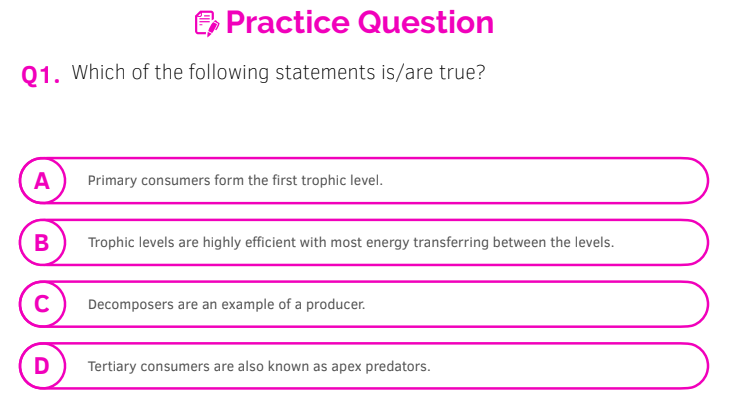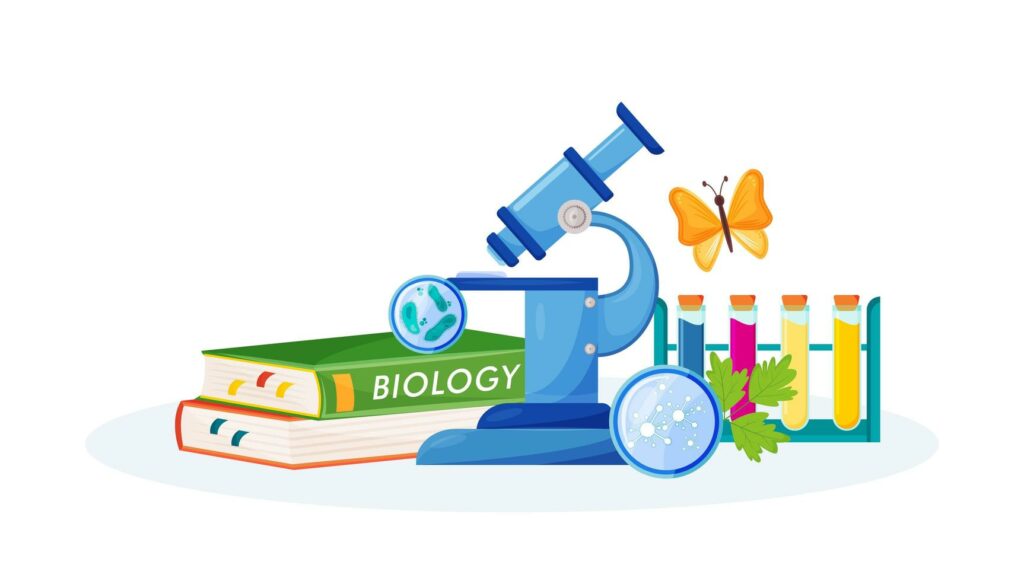4.7.4 Trophic levels in an ecosystem (biology only)
4.7.4.1 Trophic levels
Exchange in Organisms
- There is a food chain in ecosystems.
- This consists of:
- producers
- primary consumers
- secondary consumers
- tertiary consumers
- These are known as trophic levels.
Producers
- Producers provide energy to the ecosystem by photosynthesising to produce food.
- They are general algae and plants.
- This is the first trophic level.

Primary Consumers
- Primary consumers are herbivores.
- These are organisms that eat only plants.
- Examples include deer and cows.
- This is the second trophic level.

Secondary Consumers
- Secondary consumers get their energy from primary consumers.
- Therefore, organisms at this level of organisation are called carnivores.
- These types of organisms eat only animals.
- This is the third trophic level.

Tertiary Consumers
- Tertiary consumers eat the secondary consumers.
- Organisms at this trophic level are also carnivores.
- This is the fourth trophic level.
- Organisms at this level are the apex predators.
- They are prey to no one.

Efficiency of Food Chains
- Only around 10% of energy is transferred along each trophic level.
- This means that food chains are highly inefficient.

Decomposers
- Decomposers break down organic matter.
- They do this by secreting enzymes into the environment.
- Soluble food molecule then diffuse into the decomposer organism.



4.7.4.2 Pyramids of biomass
Biomass

- Biomass is tissue that is living or recently dead.
Pyramids of Biomass
- You can use pyramids of biomass to map out the trophic levels in a food chain.
- The biomass should decrease as you go up trophic levels.
- When you construct these graphs, there are a few rules:
- The producer is at the bottom of the pyramid, at trophic level 1

- You must construct the pyramid to scale.

- The bars must be equally spaced from the midpoint

- The bars must be touching

4.7.4.3 Transfer of biomass
Biomass

- Pyramids of biomass are used to show the transfer of biomass.
- In this pyramid, we measure the length of the bars to work out the biomass that is transferred.
Lost Biomass
- Pyramids of Biomass
- Only 10% of biomass is transferred.
- 90% is lost through life processes.
- This includes excretion of undigested material as faeces, respiration giving out carbon dioxide and loss of urea in urine.
- Respiration uses a large amount of glucose and so lots of biomass is lost here.

Lost Biomass and Trophic Levels
Pyramids of Biomass
- The inefficiency of lost biomass means there are rarely more than 6 trophic levels per chain.
- The energy transferred after this would be too negligible for an organism to be able to survive.

Producers and Biomass
- Producers form biomass through photosynthesis.
- They harness ~1% of the energy from the sun’s rays.
- The other 99% is lost in global warming, reflects off the plants or doesn’t reach them.

Biomass Transfer Calculations
- Efficiency of biomass transfer calculations can be done in order to measure the proportion of biomass transferred from one trophic level to another.
- It is a classic percentage calculation, so you compare the two.
- You divide the biomass of the higher trophic level by the biomass of the lower trophic level, then multiply this by 100.
- This gives you a percentage.

- So if we had a trophic level 1 with a biomass of 20kg and a trophic level 2 with a biomass of 15kg, the efficiency of biomass would be 15/20 multiplied by 100.
- This would give us 75%.

Get Access to 20 Free GCSE Tutorials









Still got a question? Leave a comment
Leave a comment